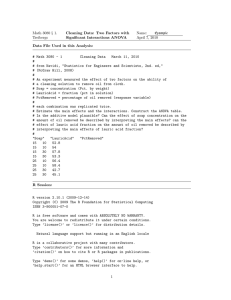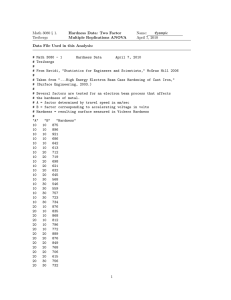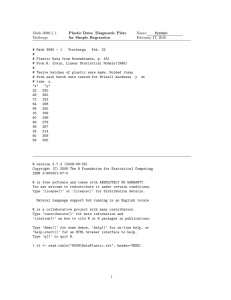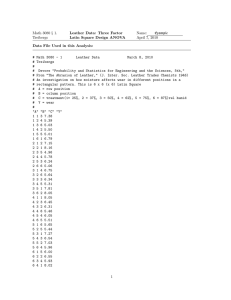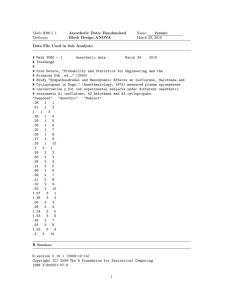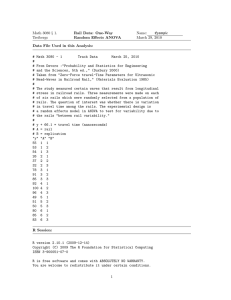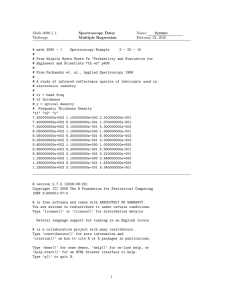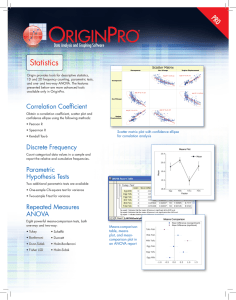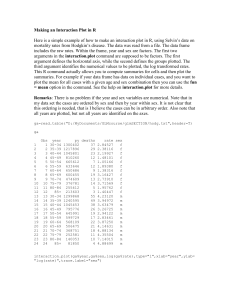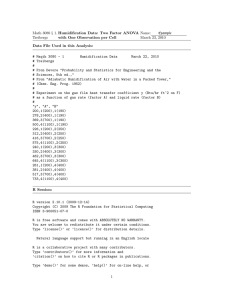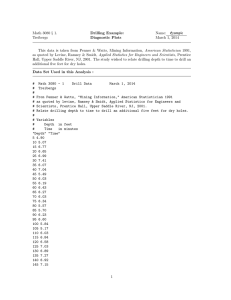Math 3080 § 1. Circuit Data: Randomized Name: Example
advertisement
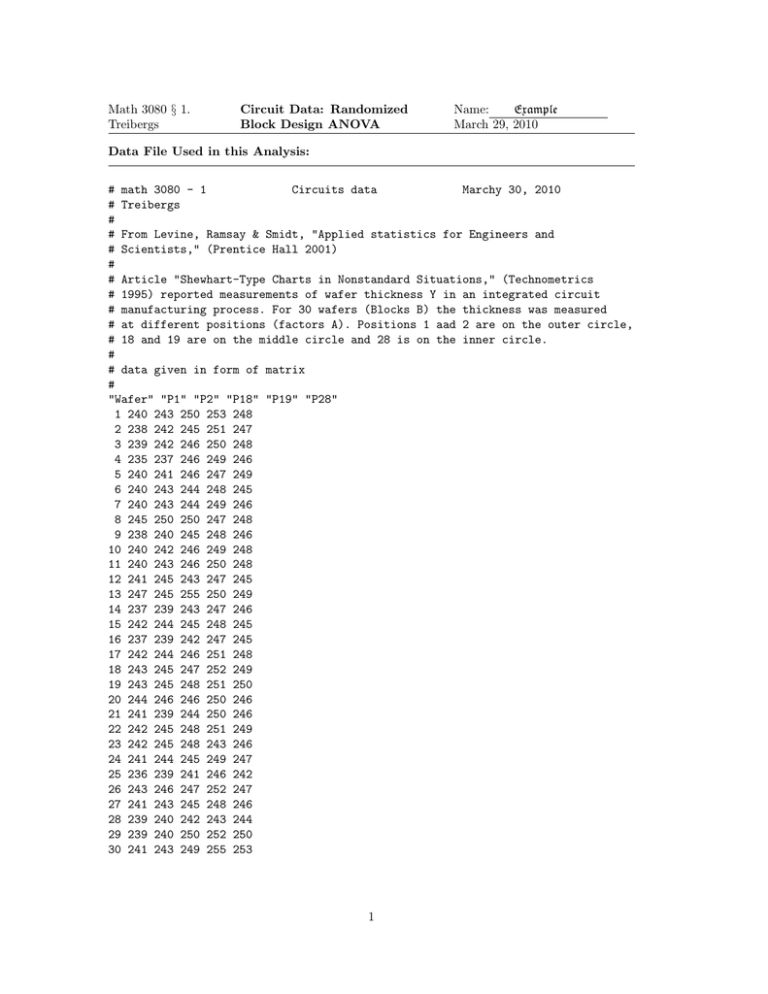
Math 3080 § 1. Treibergs Circuit Data: Randomized Block Design ANOVA Name: Example March 29, 2010 Data File Used in this Analysis: # math 3080 - 1 Circuits data Marchy 30, 2010 # Treibergs # # From Levine, Ramsay & Smidt, "Applied statistics for Engineers and # Scientists," (Prentice Hall 2001) # # Article "Shewhart-Type Charts in Nonstandard Situations," (Technometrics # 1995) reported measurements of wafer thickness Y in an integrated circuit # manufacturing process. For 30 wafers (Blocks B) the thickness was measured # at different positions (factors A). Positions 1 aad 2 are on the outer circle, # 18 and 19 are on the middle circle and 28 is on the inner circle. # # data given in form of matrix # "Wafer" "P1" "P2" "P18" "P19" "P28" 1 240 243 250 253 248 2 238 242 245 251 247 3 239 242 246 250 248 4 235 237 246 249 246 5 240 241 246 247 249 6 240 243 244 248 245 7 240 243 244 249 246 8 245 250 250 247 248 9 238 240 245 248 246 10 240 242 246 249 248 11 240 243 246 250 248 12 241 245 243 247 245 13 247 245 255 250 249 14 237 239 243 247 246 15 242 244 245 248 245 16 237 239 242 247 245 17 242 244 246 251 248 18 243 245 247 252 249 19 243 245 248 251 250 20 244 246 246 250 246 21 241 239 244 250 246 22 242 245 248 251 249 23 242 245 248 243 246 24 241 244 245 249 247 25 236 239 241 246 242 26 243 246 247 252 247 27 241 243 245 248 246 28 239 240 242 243 244 29 239 240 250 252 250 30 241 243 249 255 253 1 R Session: R version 2.10.1 (2009-12-14) Copyright (C) 2009 The R Foundation for Statistical Computing ISBN 3-900051-07-0 R is free software and comes with ABSOLUTELY NO WARRANTY. You are welcome to redistribute it under certain conditions. Type ’license()’ or ’licence()’ for distribution details. Natural language support but running in an English locale R is a collaborative project with many contributors. Type ’contributors()’ for more information and ’citation()’ on how to cite R or R packages in publications. Type ’demo()’ for some demos, ’help()’ for on-line help, or ’help.start()’ for an HTML browser interface to help. Type ’q()’ to quit R. [R.app GUI 1.31 (5537) powerpc-apple-darwin9.8.0] > tt <- read.table("M3081DataCircuits.txt",header=TRUE) > tt Wafer P1 P2 P18 P19 P28 1 1 240 243 250 253 248 2 2 238 242 245 251 247 3 3 239 242 246 250 248 4 4 235 237 246 249 246 5 5 240 241 246 247 249 6 6 240 243 244 248 245 7 7 240 243 244 249 246 8 8 245 250 250 247 248 9 9 238 240 245 248 246 10 10 240 242 246 249 248 11 11 240 243 246 250 248 12 12 241 245 243 247 245 13 13 247 245 255 250 249 14 14 237 239 243 247 246 15 15 242 244 245 248 245 16 16 237 239 242 247 245 17 17 242 244 246 251 248 18 18 243 245 247 252 249 19 19 243 245 248 251 250 20 20 244 246 246 250 246 21 21 241 239 244 250 246 22 22 242 245 248 251 249 23 23 242 245 248 243 246 24 24 241 244 245 249 247 2 25 25 236 239 241 246 242 26 26 243 246 247 252 247 27 27 241 243 245 248 246 28 28 239 240 242 243 244 29 29 239 240 250 252 250 30 30 241 243 249 255 253 > attach(tt) >#=======================================CREATE DATA VECTOR AND FACTORS FROM DATA TABLE========= > Y <- c(P1,P2,P18,P19,P28) > A <- factor(rep(1:5,each=30)) > B <- factor(rep(1:30,times=5)) > tt2 <- data.frame(A,B,Y) > tt2 A B Y 1 1 1 240 2 1 2 238 3 1 3 239 4 1 4 235 5 1 5 240 6 1 6 240 7 1 7 240 8 1 8 245 9 1 9 238 10 1 10 240 11 1 11 240 12 1 12 241 13 1 13 247 14 1 14 237 15 1 15 242 16 1 16 237 17 1 17 242 18 1 18 243 19 1 19 243 20 1 20 244 21 1 21 241 22 1 22 242 23 1 23 242 24 1 24 241 25 1 25 236 26 1 26 243 27 1 27 241 28 1 28 239 29 1 29 239 30 1 30 241 31 2 1 243 32 2 2 242 33 2 3 242 34 2 4 237 35 2 5 241 36 2 6 243 37 2 7 243 38 2 8 250 3 39 40 41 42 43 44 45 46 47 48 49 50 51 52 53 54 55 56 57 58 59 60 61 62 63 64 65 66 67 68 69 70 71 72 73 74 75 76 77 78 79 80 81 82 83 84 85 86 87 88 89 90 2 2 2 2 2 2 2 2 2 2 2 2 2 2 2 2 2 2 2 2 2 2 3 3 3 3 3 3 3 3 3 3 3 3 3 3 3 3 3 3 3 3 3 3 3 3 3 3 3 3 3 3 9 10 11 12 13 14 15 16 17 18 19 20 21 22 23 24 25 26 27 28 29 30 1 2 3 4 5 6 7 8 9 10 11 12 13 14 15 16 17 18 19 20 21 22 23 24 25 26 27 28 29 30 240 242 243 245 245 239 244 239 244 245 245 246 239 245 245 244 239 246 243 240 240 243 250 245 246 246 246 244 244 250 245 246 246 243 255 243 245 242 246 247 248 246 244 248 248 245 241 247 245 242 250 249 4 91 92 93 94 95 96 97 98 99 100 101 102 103 104 105 106 107 108 109 110 111 112 113 114 115 116 117 118 119 120 121 122 123 124 125 126 127 128 129 130 131 132 133 134 135 136 137 138 139 140 141 142 4 4 4 4 4 4 4 4 4 4 4 4 4 4 4 4 4 4 4 4 4 4 4 4 4 4 4 4 4 4 5 5 5 5 5 5 5 5 5 5 5 5 5 5 5 5 5 5 5 5 5 5 1 2 3 4 5 6 7 8 9 10 11 12 13 14 15 16 17 18 19 20 21 22 23 24 25 26 27 28 29 30 1 2 3 4 5 6 7 8 9 10 11 12 13 14 15 16 17 18 19 20 21 22 253 251 250 249 247 248 249 247 248 249 250 247 250 247 248 247 251 252 251 250 250 251 243 249 246 252 248 243 252 255 248 247 248 246 249 245 246 248 246 248 248 245 249 246 245 245 248 249 250 246 246 249 5 143 5 23 246 144 5 24 247 145 5 25 242 146 5 26 247 147 5 27 246 148 5 28 244 149 5 29 250 150 5 30 253 >#===================================================RUN RANDOMIZED BLOCK ANOVA================= > f1 <- aov(Y~A+B);anova(f1);print(f1) Analysis of Variance Table Response: Y Df Sum Sq Mean Sq F value Pr(>F) A 4 1417.73 354.43 101.2002 < 2.2e-16 *** B 29 601.50 20.74 5.9222 1.928e-12 *** Residuals 116 406.27 3.50 --Signif. codes: 0 *** 0.001 ** 0.01 * 0.05 . 0.1 1 Call: aov(formula = Y ~ A + B) Terms: A Sum of Squares 1417.7333 Deg. of Freedom 4 B Residuals 601.5000 406.2667 29 116 Residual standard error: 1.871443 Estimated effects may be unbalanced >#=============================================COMPARE TO SINGLE FACTOR ANOVA=================== >#======FOR COMPARISON ONLY===================================================================== >#====SAME WAFER IS MEASURED IN MULTIPLE PLACES SO ASSUMP. ON MODEL DON’T HOLD================== > f2 <- aov(Y~A);anova(f2);print(f2) Analysis of Variance Table Response: Y Df Sum Sq Mean Sq F value Pr(>F) A 4 1417.7 354.43 50.997 < 2.2e-16 *** Residuals 145 1007.8 6.95 --Signif. codes: 0 *** 0.001 ** 0.01 * 0.05 . 0.1 1 Call: aov(formula = Y ~ A) Terms: A Residuals Sum of Squares 1417.733 1007.767 Deg. of Freedom 4 145 Residual standard error: 2.636307 Estimated effects may be unbalanced 6 >#===================================TUKEY HSD ON RANDOMIZED BLOCK MODEL======================= > sort(tapply(Y,A,mean)) 1 2 3 5 4 240.5333 242.7333 246.0667 247.0667 249.1000 > TukeyHSD(f1,which="A",ordered=TRUE) Tukey multiple comparisons of means 95% family-wise confidence level factor levels have been ordered Fit: aov(formula = Y ~ A + B) $A 2-1 3-1 5-1 4-1 3-2 5-2 4-2 5-3 4-3 4-5 diff lwr upr p adj 2.200000 0.8609661 3.539034 0.0001266 5.533333 4.1942994 6.872367 0.0000000 6.533333 5.1942994 7.872367 0.0000000 8.566667 7.2276327 9.905701 0.0000000 3.333333 1.9942994 4.672367 0.0000000 4.333333 2.9942994 5.672367 0.0000000 6.366667 5.0276327 7.705701 0.0000000 1.000000 -0.3390339 2.339034 0.2403962 3.033333 1.6942994 4.372367 0.0000001 2.033333 0.6942994 3.372367 0.0004830 >#============================SHAPIRO-WILK TEST FOR NORMALITY OF STANDARDIZED RESIDUALS===== > shapiro.test(rstandard(f1)) Shapiro-Wilk normality test data: rstandard(f1) W = 0.9862, p-value = 0.1427 >#=====PLOT DESIGN, BOXES, TUKEY HSD, AND STANDARD DIAGNOSTICS================================ > layout(matrix(1:2,ncol=2)) > plot.design(tt2) > plot(Y~A,xlab="Position") > layout(1) > plot(TukeyHSD(f1,which="A",ordered=TRUE)) > abline(v=0,lty=5) > layout(matrix(1:4,ncol=2)) > plot(A,Y,xlab="Position") > plot(rstandard(f1)~fitted(f1),ylab="Standard. Resid.",xlab="Predicted Values", ylim=max(abs(rstandard(f1)))*c(-1,1)) > abline(h=c(0,-2,2),lty=c(2,3,3)) > plot(fitted(f1)~Y,ylab="y hat");abline(0,1,lty=5) > qqnorm(rstandard(f1),ylab="Standard. Resid.", ylim=max(abs(rstandard(f1)))*c(-1,1)) > abline(0,1) > layout(1) > interaction.plot(A,B,Y) 7 8 9 10 11
